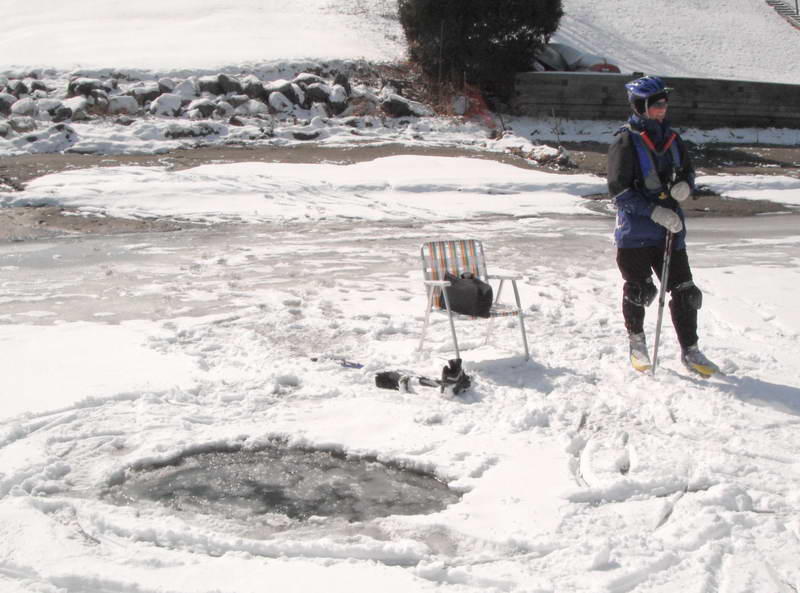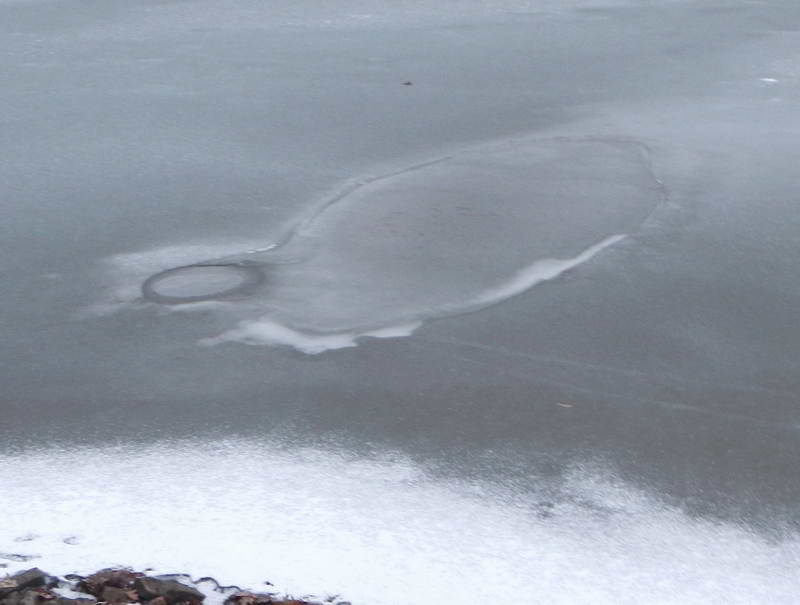Spring Holes
Summary:
I have never found a clear example of a hole created by a natural spring. The reason is spings on the bottom of a lake rarely have sufficient energy to overcome the the the convective stablity of the water column under theice.
This page discusses holes made by pond bottom springs, why they are rare and other types of holes that are frequently mistaken for springs.
Detail
Some underice culvert have sufficent flow and temperature. On this page they are being considered manmade springs.
 A spring hole near Bayside Park in Colchester VT. The water is a couple feet deep and it would be easy to put a leg through if you did not know where it was. On this day it was skinned and snow covered when we arrived. I had to hunt for it so I could break up the skin to make it more visible. It is most likely fed by a drainage culvert.
A spring hole near Bayside Park in Colchester VT. The water is a couple feet deep and it would be easy to put a leg through if you did not know where it was. On this day it was skinned and snow covered when we arrived. I had to hunt for it so I could break up the skin to make it more visible. It is most likely fed by a drainage culvert.
Spring holes occur over springs or underwater culvert outlets that bring water warmed by the its passage underground. They form when the inflow of heat from the spring is not overpowered by the rate of freezing of the ice. Often in mid winter, ground water flows diminish which also lets them freeze over easily. They often re-form in the spring after as the weather warms up and ground water flows increase. They occur at the same place from one season or year to the next (gas holes and reef holes also have this characteristic).
After a warm spell in early spring, the hole shown below opened up. I dangled a thermister into it and found changes in temperature of a few degrees over periods of roughly 20 seconds. I expect this is from the turbulent flow of low density warm water up through the colder pond water. For this to work the incoming water needs to be warm enough and have enough flow to penetrate the the reverse density layer I did not see these temperature swings in the water over the hole when I measured the temperature in mid winter when the hole was covered with relatively thick ice and the culvert flow was probably quite low.
While many people attribute holes to springs, spring holes are much less common than you might think. Most of the time they are gas holes which can easily be identified by watching them for a few minutes. If any bubbles come up it is a gas hole. New-ice holes also get blamed on springs but they are only found on new ice and they do not occur at the same place from year to year. Reef holes do occur in the same place year to year but the presence of the reef is usually well know. Wind holes are also common but they do not occur in the same place from year to year. I have looked at a lot of holes and the only two I am convinced were spring holes are the culverts show in in the adjoining pictures.
There are uncommon under-ice streams that are apparently fed by shore line springs or warm spell run off creeks that inject warm ground water under the ice. They are an uncommon special case. Click here to read about them.
 A skinned over, 12" diameter spring hole (lower left) over a drain covert in a golf course pond. It has a larger area of current melting going to the upper right. This hole was present in the first part of winter and came back during the spring thaw.
A skinned over, 12" diameter spring hole (lower left) over a drain covert in a golf course pond. It has a larger area of current melting going to the upper right. This hole was present in the first part of winter and came back during the spring thaw.
Bob December 2019
